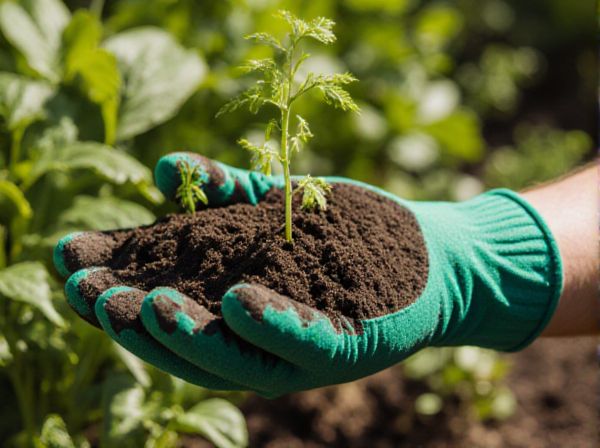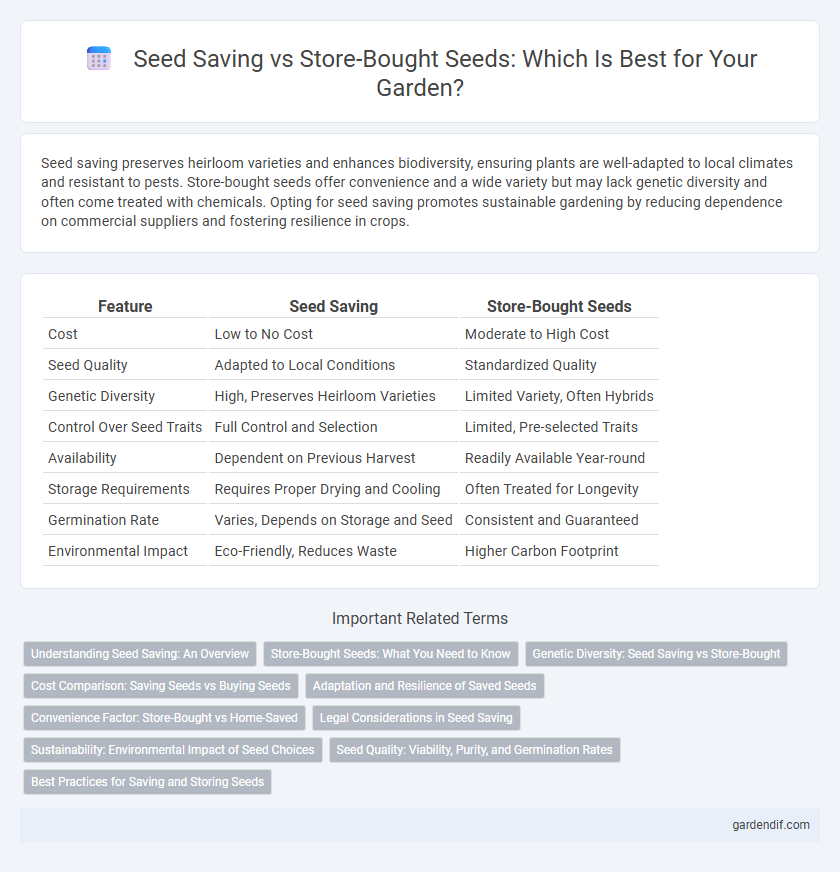
Seed saving vs Store-bought seeds Illustration
Seed saving preserves heirloom varieties and enhances biodiversity, ensuring plants are well-adapted to local climates and resistant to pests. Store-bought seeds offer convenience and a wide variety but may lack genetic diversity and often come treated with chemicals. Opting for seed saving promotes sustainable gardening by reducing dependence on commercial suppliers and fostering resilience in crops.
Table of Comparison
| Feature | Seed Saving | Store-Bought Seeds |
|---|---|---|
| Cost | Low to No Cost | Moderate to High Cost |
| Seed Quality | Adapted to Local Conditions | Standardized Quality |
| Genetic Diversity | High, Preserves Heirloom Varieties | Limited Variety, Often Hybrids |
| Control Over Seed Traits | Full Control and Selection | Limited, Pre-selected Traits |
| Availability | Dependent on Previous Harvest | Readily Available Year-round |
| Storage Requirements | Requires Proper Drying and Cooling | Often Treated for Longevity |
| Germination Rate | Varies, Depends on Storage and Seed | Consistent and Guaranteed |
| Environmental Impact | Eco-Friendly, Reduces Waste | Higher Carbon Footprint |
Understanding Seed Saving: An Overview
Seed saving involves collecting and preserving seeds from mature plants to use in future planting, promoting genetic diversity and adaptation to local conditions. Unlike store-bought seeds, which are often hybrid varieties with limited viability and may not produce true-to-type offspring, saved seeds retain traits specific to their growing environment. This practice supports sustainable agriculture, reduces dependency on commercial suppliers, and fosters resilience in crop production.
Store-Bought Seeds: What You Need to Know
Store-bought seeds are often hybrid varieties, which means they may not produce true-to-type plants if saved and replanted. These seeds are typically treated for higher germination rates but can include chemicals that affect soil health. Understanding the source and quality of store-bought seeds is essential for gardeners aiming for reliable growth and sustainability.
Genetic Diversity: Seed Saving vs Store-Bought
Seed saving preserves genetic diversity by maintaining heirloom and locally adapted varieties that store-bought seeds often lack due to commercial hybridization and uniformity. Farmers and gardeners who save seeds contribute to resilient crop populations capable of adapting to environmental changes and pest pressures. Store-bought seeds typically represent a narrow genetic pool, reducing biodiversity and increasing vulnerability to diseases and climate shifts.
Cost Comparison: Saving Seeds vs Buying Seeds
Saving seeds from your own garden significantly reduces costs compared to purchasing store-bought seeds, which can add up annually. Home-saved seeds eliminate recurring expenses and allow gardeners to select plants adapted to local conditions, improving yield and sustainability. Over time, seed saving proves to be a more economical and environmentally friendly option than continuously buying commercial seed packets.
Adaptation and Resilience of Saved Seeds
Saved seeds exhibit greater adaptation and resilience compared to store-bought seeds due to their ability to naturally evolve in response to local environmental conditions over multiple growing seasons. This process of selective saving enhances traits such as drought tolerance, pest resistance, and soil compatibility, resulting in stronger, more robust plants. Consequently, gardeners and farmers relying on saved seeds benefit from increased crop stability and sustainability in the face of climate variability.
Convenience Factor: Store-Bought vs Home-Saved
Store-bought seeds offer unmatched convenience with uniform packaging, clear labeling, and easy availability, streamlining the planting process for gardeners. Home-saved seeds provide the advantage of adaptation to local growing conditions and can result in cost savings over time but require time-consuming collection, cleaning, and proper storage. The choice between the two depends on balancing immediate ease of use and long-term sustainability benefits.
Legal Considerations in Seed Saving
Legal considerations in seed saving vary widely by country, often influenced by plant breeders' rights and patent laws that restrict saving patented or hybrid seeds. Farmers must navigate regulations such as the International Union for the Protection of New Varieties of Plants (UPOV) agreements, which protect breeders' intellectual property and limit the reuse of commercial seeds. Understanding local seed laws is crucial to avoid legal penalties and ensure compliance when saving seeds for future planting.
Sustainability: Environmental Impact of Seed Choices
Seed saving promotes sustainability by preserving genetic diversity and reducing reliance on industrial agriculture, which often depends on chemical inputs and monoculture practices. Store-bought seeds typically come from hybrid or genetically modified varieties that require intensive resource use, contributing to soil depletion and increased carbon emissions. Choosing saved seeds minimizes environmental impact through natural adaptation and lower input demands, fostering resilient ecosystems and sustainable food systems.
Seed Quality: Viability, Purity, and Germination Rates
Seed saving preserves genetic diversity, often resulting in higher seed viability and purity compared to many store-bought seeds that may undergo chemical treatments or long storage periods. Home-saved seeds typically exhibit enhanced germination rates as they come directly from locally adapted plants, ensuring better compatibility with the growing environment. In contrast, store-bought seeds can suffer reduced vigor due to standardized production processes and extended shelf life, which can compromise seed quality over time.
Best Practices for Saving and Storing Seeds
Saving seeds from open-pollinated plants ensures genetic diversity and adaptability to local growing conditions, unlike many store-bought seeds which may be hybrids or treated for uniformity. Best practices for seed saving include selecting healthy, robust plants, allowing seeds to fully mature, and thoroughly drying them before storage to prevent mold and decay. Store seeds in airtight containers kept in a cool, dark, and low-humidity environment to maximize viability and longevity over multiple planting seasons.
Seed saving vs Store-bought seeds Infographic

 gardendif.com
gardendif.com